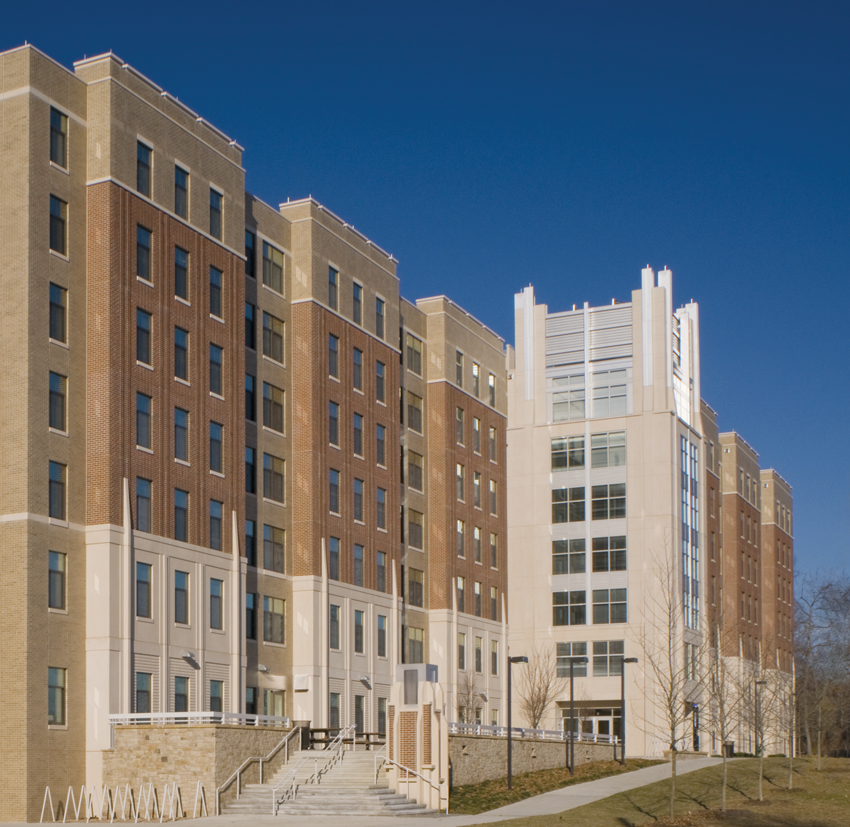Collaborating Through Design Challenges
Modern Student Housing Must Also Embrace Sustainability
Balancing amenities, private space, and shared areas is a large enough challenge. Yet a well-planned location and thoughtful design can be undermined if sustainability isn’t accounted for. The term ‘sustainability’ in student housing encompasses a number of factors; besides incorporating ‘green’ or efficient features, it also means an adaptable, multipurpose building that is eminently usable and maximizes both square footage and dollars. “Mixed-use, multifunctional residence halls will continue to make sense in the future, as institutions may choose to decrease beds in favor of adding classrooms or social areas, whether to address shifting student populations or facility needs.”5
Concern for “improved health and well being” is the number-one reason for constructing sustainable buildings on campus, according to McGraw-Hill Construction.7 A sustainable structure not only conserves dollars by keeping utility costs down, it also bolsters indoor air quality and comfort.
Attracting and Retaining Students While Minding the Budget
With the reality that the median cost for a residence hall is $20 million, or $171 per square foot, how dollars are spent is vital to both the bottom line and the ability for the university to attract and retain students.8 While more students than ever before are entering undergraduate schools, resulting in a high demand for housing, university budgets for this housing are being extremely curtailed.
Given time constraints, inflexible budgets, and the need for precise coordination, the design-assist movement is gaining prominence as a best practice in managing construction of student housing. The design-assist practice uses a three-step process: development of a clear statement of work; research and creation of specifications; and adaption of the construction contract to reflect the goals created in steps one and two. “Design-assist contracting is a construction management method to improve quality and maintain cost. It is most commonly used when a specialty trade, fabrication or building method requires a unique solution or set of trade skills,” writes David Hart, AIA. “Design-assist contracting is best suited for design-build or construction management at risk (CM@R) projects in which the architect and owner work with trades people, manufacturers, and subcontractors to develop a budget and project schedule for a unique solution, material, or construction application, such as reproducing historic windows or finishing plaster walls.”9
By investing time and thoughtful planning at the initial stages of a project, universities and housing managers can better define goals for their buildings and better ensure the buildings’ full realization within set timeframes and budgets.
What Students are Asking for in Housing (and Why It's Important)
With record numbers of students coming through the doors of American universities and colleges in 2016, the market for campus housing is strong. The goal for institutions of higher learning competing for this pool is not only to attract, but to retain, students. A key to gauging the demands of this audience comes via refocusing perspective. “Reduced attrition and increased retention is dependent upon a shift in perspective from an institutional to a student perspective.”10 While not a client in the traditional sense, by understanding and incorporating student desires, universities and colleges can better leverage a campus necessity—housing—as a strong suit. As institutions and housing managers adopt the mindset of students as clients, we ask the simple yet vital question: “What do students have to say about campus housing?”

Photo courtesy of Little/© John Cole, 2009
Pictured is the tower facade of Opus Hall at Catholic University of America. Installation of all precast concrete exterior wall panels took only 35 days, and the panels earned a 4-plus hour fire rating, an R-Value of 14.25, and a sound transmission coefficient of 54.









